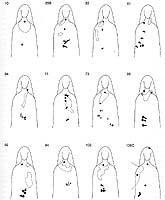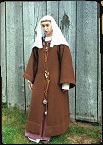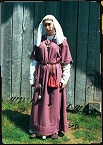 |
||||||||
|
Lesson #3: Page 8
During the 6th century Jutish influence on material culture in Kent seems to have been reduced to square headed brooches with remnants of Jutish animal style ornament and to bracteates, which are considered to have been high-status objects, probably treasured over several generations. The 6th century Frankish influence on Kent is very strong, but selective. There are brooches imported from almost every part of the Frankish realms, mainly produced in a series but with a few individual creations. However, there are almost no ear-rings, hairpins or metal fittings from garters or shoes. The use of this limited range of continental objects also tended to be unorthodox – brooches were worn in unusual numbers and combinations; buckles and strap-ends were used by women more often than men, whereas on the continent only men wore them. There are very few well-furnished female Kentish graves that would not look out of place in a Frankish cemetery. Numerous annular brooches found in Kentish graves show a clear connection between Anglian and Kentish material culture. There are several well-furnished Kentish graves that would make convincing ‘Anglian’ burials. Saucer and disc brooches are less common than annular brooches and there seems to be no well-furnished grave that would pass for typically ‘Saxon’. #2 The fragmentary evidence of the ethnic background of late 5th to 6th century material culture and burial rites in Kent does not allow and definitive reconstruction or identification of ‘first generation’ of settlers, dressed and buried traditionally. Neither can we detect sufficient links between the late Roman and early Anglo-Saxon evidence to show an acculturation process under the pressure of a small group of invading leaders. Whoever the Kentish Anglo-Saxons were, they quickly adopted an ethnic identity of their own, with only influences from the Continent and Scandinavia. However, the combination and arrangement of female dress accessories found in well-furnished early and mid 6th century Kentish graves is not as random as it may seem from what has been said so far. Differences are detectable between Anglo-Saxon and Franco-Kentish fashion. As we have seen, the traditional idea of a ‘complete’ Anglian woman’s dress is of two cruciform, small-long or annular brooches worn at the shoulders and a brooch on the chest, probably fastening a cloak, whilst a Saxon woman is supposed to have two small-long, saucer or disc brooches worn at the shoulders. The pairs of brooches used in Anglo-Saxon dress also served to fix strings of beads. Contemporary Frankish women wore up to four brooches, usually two small ones above the waist and two bow brooches at or below the waist. Buckles with club-shaped tongues, shield on tongue buckles and shoe-shaped rivets, on the continent, were usually worn by men, but in Kent they belonged mainly to women’s fashion. Beads of glass and amber were commonly
worn in Kent, but the way they were worn seems to be different when associated
with Franco-Kentish brooches. Instead of being worn between
two brooches in the Anglo-Saxon style they seem to have been worn around
the neck (like a modern necklace) or suspended in a loop from one brooch. #3
The numbers of beads found per grave are quite high, with some graves producing
over 400 beads. Single beads or small groups are also found
in association with bags or girdle hangers.
Anglo-Saxon style brooches were not usually worn with Franco-Kentish and continental type brooches. It seems that Jutish-Kentish brooches could be worn with either Anglo-Saxon or Franco-Kentish objects. This is not surprising if it is accepted that the Jutish element was the longest established tradition in Kent. It is more surprising to find that bracteates were only worn with Franco-Kentish brooches and were not combined with Anglo-Saxon ones. Anglo-Saxon brooches were mostly worn in pairs positioned at the shoulders, as in the homelands and other parts of England. Women wearing Franco-Kentish brooch types generally had three to five brooches altogether and often a continental style buckle. An understanding of continental dress habits may shed some light on the situation in Kent. Gallo-Roman dress required only a single brooch at the neck and a decorative belt-buckle. For Scandinavian and Saxon dress a pair of brooches worn at the shoulders were required. For Frankish dress several brooches were used with a simple belt buckle. A ‘complete’ set of brooches consisted of two pairs of small- and bow-brooches. The small-brooches are usually found in the neck and chest area, with the two bow-brooches below. Sets of more than four brooches were rare after the 5th century and the wearing of small-brooches at the shoulders was given up early in the 6th century. A look at the total numbers of brooches worn in sets by women in Kent shows that most had between one and four brooches in the continental fashion. However, a comparatively large number of women in Kent were buried wearing five or six brooches. It can be seen that in Kent women followed two main types of fashion, Anglo-Saxon and Franco-Kentish. Whether these fashions expressed identity acquired at birth or allegiance to a certain group is unknown. Anglo-Saxon brooches were worn in the traditional way, while some of the Frankish types of dress accessory were apparently used in disregard or ignorance of continental habits. Jutish-Kentish types of brooch were combined with both Anglo-Saxon and Franco-Kentish brooches, but bracteates occur only with Franco-Kentish types. #4 What is clear is that the Franco-Kentish group displayed greater wealth than those following Anglo-Saxon fashions. Gold, garnets and to a large extent also silver, seem to have been restricted to this group. Gold was used in braids, as bracteates and for gilding on brooches. Almost all of the perforated silver spoons and crystal balls have been found with Franco-Kentish dress accessories. The Kentish brooches are mostly of better quality and workmanship than the imported brooches associated with them. In contrast to this the graves of the Anglo-Saxon group would not have stood out as particularly wealthy if found in Anglian or Saxon regions. The types of object worn by the Franco-Kentish group were similar to those used in Anglo-Saxon (and probably Jutish) dress, which is possibly the reason why no hairpins, ear-rings or metal fittings for garters and shoes occur. Possibly for the same reason women adopted male ornamental buckles and strap-ends. They appear to have had a style of dress different to the usual Anglo-Saxon peplos fastened on the shoulders. Continental types of objects obviously had some significance for their wearers. Some objects may have reflected the wealth of the Franks, from whom the Kentish economy profited by so much more than the other Anglo-Saxon Kingdoms. However, Kentish jewellery was mostly of better quality than much of the imported Frankish material. In the 6th century the only objects made of solid gold were bracteates. These provide an outstanding demonstration of the Jutish-Kentish connection, implying that although continental material was used extensively, in terms of importance it was kept in a secondary position. Franco-Kentish dress may have been worn by local women to signal both their Kentish identity and their Jutish and Frankish connections. The use of dress accessories suggests that these women had an Anglo-Saxon or possibly Romano-British background, but they may not represent immigrants. #5 Despite the strong Frankish influence
on material culture in Kent, it is unlikely that Kent was ruled by Frankish
invaders. Though historical sources indicate Frankish political
influence on Kent, archaeological sources suggest that Kentish high society
used high status objects made in Kent to demonstrate Kentish independence.
Reconstructing the
Dress of a Kentish Woman
Over this an ankle length, open-fronted robe with long, loose sleeves could be worn, pinned with pairs brooches at the chest and waist or belted with a simple belt. It seems that the lower pair of brooches may also have sometimes been used to pin the two sides of the robe open, revealing the garment beneath. Frequently from the lowest brooch or the belt a silver caged crystal ball, often with a perforated silver spoon, would hang, in addition to the items normally found hanging from the belt. The exact purpose of this ball and spoon is uncertain, and it is usually ascribed ritual significance. The hair was covered with a cap, pinned to the hair, and over this a fine veil was worn, pinned at the chest with a long pin or brooch. When the veil was removed, ear-rings could often be seen. An alternative mode of dress involved the open-fronted robe being replaced with a cloak (either rectangular or semicircular). In this case the pair of small brooches were used to pin the cloak at the chest whilst the bow-brooches were pinned to the tunic at the waist and used to suspend various items. As we have seen, the shoe and garter buckles were not worn in Kent, suggesting that the Kentish version of the dress was probably ankle-length rather than tunic like. It may have been like the Frankish version, or it may have simply been a peplos type gown sewn at the shoulders instead of pinned. Whether the open-fronted robe or a cloak was worn over this is unclear, and perhaps both fashions existed. The lack of hairpins and ear-rings suggests that headwear was different. The veil was a common part of Kentish costume, and it is very likely to have covered the ears since ear-rings have been found, but worn on necklaces rather than in the ears. This style of head-dress may have come from the continent, where Christianity was influencing dress and lifestyle. Rather than pinning into the hair, it was probably held in place by the gold brocaded fillets mentioned before (which may have been restricted to those of royal birth – women lower down the social scale may have just worn simple braid fillets). A buckled belt and abundance of jewellery are also common features of Kentish costume. As has already been seen, even the fabrics used for the clothing are different, with tabby weave accounting for over 50% of the textiles from Kentish graves. This costume is more typical of Frankish than English styles, and has its ultimate source in Byzantium. The strong Frankish influence is probably caused by a combination of the Kentish Anglo-Saxons probable origin in Jutland and Frisia and their closeness to the Frankish Empire. However, differences between the Kentish and Frankish costumes show that Kentish costume was not a slavish following of Frankish fashion, just that a number of Frankish, ultimately Byzantine, trends influenced Kentish women in the upper strata of society. Click on image for a larger version in new window 1 Research is made more difficult by the fact that 5th and 6th century graves excavated in Jutland tend not to be furnished with grave-goods; most of the Jutish brooches and bracteates from Jutland are either from hoards or settlement sites. However, the number of Migration Period burials discovered there has grown over the last few decades, some of them with dress accessories and personal equipment. back 2 Saucer brooches become more common as you go West of the River Medway, perhaps an influence of the neighbouring Saxon Kingdom of Sussex. In Anglo-Saxon times the population was identified as East Centings or West Centings depending on which side of the Medway they lived. It is interesting to note that even to this day the River Medway marks the boundary between the ‘Men of Kent’ and the ‘Kentish Men’ (A Man of Kent is born East of the River Medway and a Kentish Man is born West of the Medway, whereas all women born in the county are Fair Maids of Kent - after 14th-century Joan Plantagenet - the stunning daughter of the Earl of Kent.) Perhaps the difference in Saxon and Anglian areas of Kent is still there! back 3 The suspension of beads from a brooch at the neck is known from Late Antique fashion and was imitated in the Frankish realm from the middle of the 6th century onwards. back 4 Unfortunately, it is not possible at present to precisely date Anglian and Saxon brooches so it is difficult to say whether the two fashions were entirely contemporary. back 5 There is a strong suggestion that many, if not most, Kentish women were native women married to men of Germanic origin, a picture that would fit in well with the idea of the first Anglo-Saxon settlers in Kent being Germanic mercenaries who rebelled against their British overlords. The skeletal evidence from Kent would seem to suggest this too, with most Kentish women being shorter than the Anglo-Saxon average (and closer to the Romano-British average) although the men are generally of Anglo-Saxon height. back 6 The cut of this tunic was probably that shown for the simple underdress shown earlier, although it would be of fine wool or even, in very high status burials, of silk. back Page
1 | Page 2 | Page
3 | Page 4 | Page
5 | Page 6 | Page
7 | Page 8
|
||||||||
| Costume
Classroom is a division of The
Costume Gallery, copyright 1997-2002.
Having problems with this webpage contact: questions@costumeclassgallery.com |
||||||||





